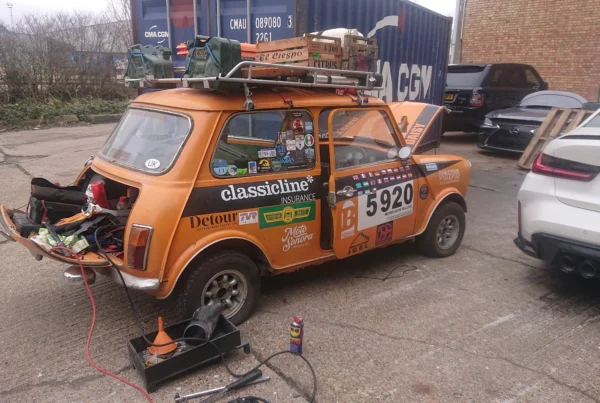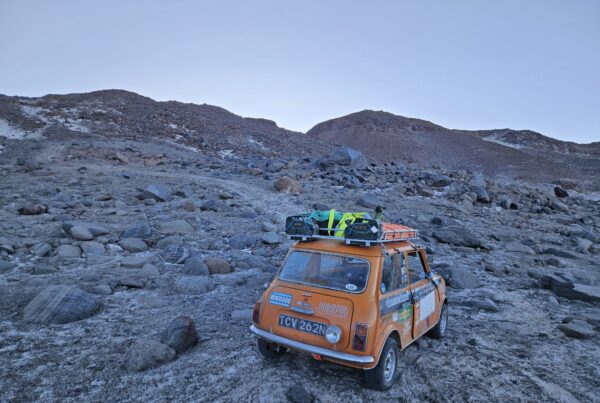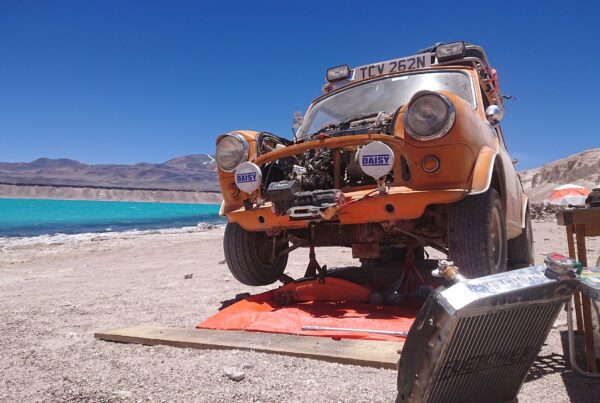The Mini6000 team spent over three weeks deep in the wilderness, living on the side of a volcano. But how, exactly? ClassicLine’s resident road tripper, Ben Coombs, explains…
Car camping. It’s something we’ve all done, and it represents perhaps the ultimate in automotive freedom. Its simplicity itself – just you, your car, and everything you need to survive for a weekend or a week, heading off on an adventure. There’s no need for a fixed destination, and the contents of just a few bags in the boot can provide you with shelter from the elements, a bed for the night, a pop-up kitchen and whatever else you need to provide you with the comforts of home, transposed into the great outdoors. And naturally, with this ensemble loaded into your classic car, you’ll head to the places which promise a pleasant weekend or week away for you.
But what if your camping trip is taking place in the world’s driest desert, on the side of the world’s highest volcano, 150 miles from the nearest shop, café or petrol station? And you’ll be spending at least three weeks there? Then, the carefree nature of a typical weekend under canvas in Cornwall is lost, for it’s no longer a relaxed camping trip you’re planning; it’s a mountaineering expedition.
Living in this environment for an extended period of time was one of the biggest challenges we faced during the ClassicLine Insurance sponsored Mini6000 Expedition. We’ve already covered how we coped with the difficulties of altitude and logistics in the previous article, so here we’re going to zoom in and look at our day-to-day life on the mountain. How exactly did we live?
For 23 days, our homes were our tents, which were pitched in no less than seven different locations as we moved up the mountain. This meant that being minimalist was important, as everything needed to be quick and easy to pack away, and then set up again at the next camp spot – so, no big and complex tent-palaces for us. Additionally, our tents needed to be able to cope with the weather, which except for a blissfully quiet hour or two each morning, was invariably dominated by fairly strong, gusty winds. Due to this, all the tents we slept in on the trip were small, serious affairs, built for high mountain use by trusted manufacturers such as Alpkit, Mountain Hardwear and Hemiplanet. As we were pitching them in soft sand, conventional pegs were often useless, and so they were often tied down to rocks, or lashed to buried tools, to stop them blowing away.
The next challenge was the temperature. Overnight lows approached minus twenty, while during the day, the burning sun combined with the thin air to roast any unprotected skin. The low temperatures were fairly easy to deal with – chunky down sleeping bags and thick thermarests at night, and a sensible layering system of clothes during the day, starting with merino wool baselayers against the skin, and finishing with that ultimate protection against the cold – a chunky down jacket. Or two, in my case. Additionally, when high on the mountain, a combination of sturdy mountaineering boots and warm gloves protected against frostbite. Meanwhile, a combination of shady hats and strong suncream protected us from the sun’s rays.
Naturally, 150 miles from civilisation, the normal means of staying in touch with the outside world weren’t an option. With this in mind, we brought along a Starlink satellite internet system, powered by a large solar panel and leisure battery. This enabled us to communicate in real time, and also served as a lifeline should we require emergency assistance. Compared to conventional satellite phones, it was certainly a good choice, and worked well in throughout the trip.
As you’ve probably worked out by now, our days on the mountain were dictated by the weather. We’d get up when the sun hit the tents, raising the temperature from the frigid to the tolerable. Breakfast would consist of whatever the last supply run delivered, with cereal bars and cake being a regular favourite, and water would be boiled for drinks. For this, we solely used Primus Omnifuel stoves running on petrol, as burning the same fuel as the cars simplified logistics, and having used Primus stoves on previous trips over several decades, they’re a piece of equipment I know well. One quirk on Mini6000 is that at altitude, water takes much longer to boil, even though it does so at a lower temperature. This meant that sometimes we were waiting for over half an hour for our first instant coffee of the day – it was always worth the wait though.
Morning was the time to work on the cars, as the air was at its most still. By late morning, the rising wind would pick up the sand and ash and fling it through the air, sometimes giving the sensation of existing in a shotblaster when it was at its worst. Naturally, this made most tasks unpleasant at the very least, and some jobs, such as working on carburettors, became impossible. The blown sand caused other issues too, such as clogging the tent zips and making them almost inoperable, and killing the cooling fan on our laptop computer. However, in spite of the wind and the sand, there were always things to do during the day – acclimatisation hikes, investigating the onward route, planning the coming days and fixing and preparing equipment. Or, just ignoring it and working on the cars anyway, because they certainly required a lot of attention.
Our original plan for dinner involved plenty of creative cooking; we soon discovered that this was far too ambitious. While bigger parties on the mountain, such as organised climbing groups, or manufacturer backed record attempts, would have meals prepared for them by local guides, we had no such luxury, and finding the energy for cooking at the end of a long day was difficult at best. Therefore, the evening meal often consisted of a pot noodle, along with fruit and a range of high calorie additions to keep up energy. However, despite our best efforts to snack throughout the day and keep up our calorie intake, we all lost weight on the mountain, to the tune of around 5kg in three weeks – a pretty standard outcome to a mountaineering expedition such as this.
After dinner, the end of the day was once again dictated by the sun. Once it moved behind a ridge and shade enveloped us, the cold became almost instantly became overwhelming, and a retreat to the tents was made, where we’d generally discuss the plans for the following day, before turning in for the night.
And then, the following day, we’d once again rise with the sun, and repeat the routine, gradually moving higher on the mountain every few days as we did so – provided the cars were working, of course. But that’s a whole different subject, which we’ll be covering in the next instalment.












